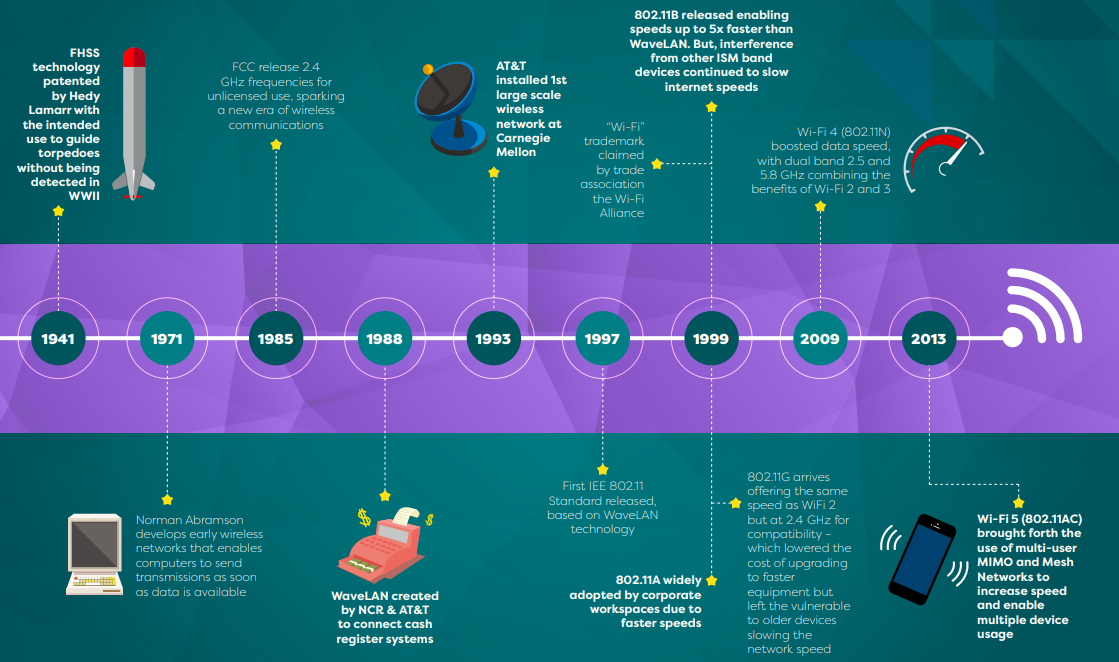Paris
20 Years of Wi-Fi Report
It’s been twenty years since Wireless Fidelity was invented and first released for consumers by the IEEE committee 802.11. In the decades since it is no understatement to say that the WLAN technology has revolutionised how individuals and society connect and operate.
Introduction
Wi-Fi is considered so essential to our daily lives today that it is viewed as a utility. It’s the first thing we ask for when visiting a friend’s house; we demand access – for free - in public areas like airports and are frustrated when we cannot connect. Alongside laptops, phones, and tablets, people are connected to a growing range of other devices from wearable health monitors to smartwatches as the ubiquity of Wi-Fi helps accelerate the era of the Internet of Things.
It is no question that connectivity will be further boosted by the imminent introduction of Wi-Fi 6, the latest iteration of the international standard which is designed to ease the limitations on the network inherent in IEEE 802.11ac by, among other things, connecting to multiple devices at a time.
This feature provides a rapid overview of how we got here, and where the technology will go to next.
A Brief Background
20 YEARS OF WI-FI

CONGESTION BUILDS
Since its inception, the Wi-Fi standard has elegantly married multiple parts of the IEEE 802 protocol to seamlessly interconnect with Ethernet. Successive improvements (variously 802.11a, 802.11b, 802.11g, 802.11n, and more) have upped the ante in terms of performance.
The current standard, 802.11ac (Wi-Fi 5), arrived in 2013 and – as we know - allowed the full implementation of multi-user MIMO and 4X4 spatial multiplexing to achieve communication rates of 1Gbps under optimal conditions. This supported the growth of several new WLAN applications, such as simultaneous streaming of HD video to multiple clients and rapid synchronisation and backup of large data files. Despite employing CSMA/CA (carrier-sense multiple access with collision avoidance), however, the networks remain susceptible to interference. Competition in the 2.4 GHz band come from microwave ovens to ZigBee and Bluetooth devices among others, while the shorter range of 5 GHz bands are absorbed by building materials making deployment in high-density areas, such as apartment complexes, problematic. The multiplicity of Access Points (AP) in congested areas also cause Wi-Fi 5 connections to suffer from overlapping channels and data-hungry applications.
With the average household containing ten connected devices – a figure which is forecasted to explode to 50 in the next few years according to Intel - the introduction of High Efficiency Wireless in E 802.11ax (Wi-Fi 6) cannot come soon enough.

WHAT THE INDUSTRY IS SAYING...
“With the average household containing ten connected devices – a figure which is forecasted to explode to 50 in the next few years according to Intel - the introduction of High Efficiency Wireless in E 802.11ax (Wi-Fi 6) cannot come soon enough.”
ENTER WI-FI 6
802.11ax is Wi-Fi’s logical evolution. Unlike previous Wi-Fi standards, this new version isn’t focused on purely boosting headline speeds but prioritises to manage the connectivity strain caused by the ever-increasing number of connected IoT devices and smart home gadgets.
Specifically, 802.11ax is designed to operate between 1 and 7 GHz in addition to 2.4 and 5 GHz at theoretically 10x faster data rates (real-world speeds will probably be around 2 Gbps). For crowded environments such as stadia, throughput is amplified up to 4x using higher order 1024 QAM modulation.
It delivers an improved experience (higher speeds, lower latency) for more users and devices in outdoor or dense environments while also providing flexible support for the differing requirements (low power, wide area) of the IoT. With the added capabilities of MU-MIMO it will be possible for more than 30 clients to receive and transmit data back to the network at the same time.
If that sounds like a match for the attributes designed into 5G, then that’s because the architectural keys to 802.11ax are identical. Both rely on Orthogonal Frequency Division Multiple Access (OFDMA), a protocol which when applied to Wi-Fi makes the network less prone to interference, improves spectral efficiency, and boosts performance at the Edge.
What’s more, Wi-Fi will share the same MAC layer as cellular. This means that devices should more elegantly switch between mobile and Wi-Fi. Nor is 802.11ax the only Wi-Fi technology in town. Complementary to Wi-Fi 6 is the latest version of WiGig (802.11ay) which support deployments in the 60 GHz band and is primed for applications requiring very high speed over small obstacle-free distances.
One example is a computer powering an 8K resolution VR headset in the same room, wirelessly; something that will undoubtedly transform the gaming experience for individuals across the globe.
HaLow (or IEEE 802.11ah) operates in the 900 MHz band and is geared toward IoT devices, requiring longer range, lower bandwidth, and lower power – such as smart homes, cars, wearables and smart industries such as agriculture and retail. It will associate with Wi-Fi networks in the 2.4/5 GHz bands if the equipment supports it.
Paris
“One example is a computer powering a 8K resolution VR headset in the same room, wirelessly; something that will undoubtedly transform the gaming experience for individuals across the globe.”
Looking to the Future
WI-FI AND 5G
It’s clear that Wi-Fi will be integral to the fixed and mobile broadband experiences going forward. Indeed, Wi-Fi will increasingly be used for off-loading and even for backhaul, in the case of WiGig.
With 5G promising to bring billions of new devices online, all with varying requirements, the importance of Wi-Fi cannot be discounted; particularly when evaluating how to best support enhanced mobile broadband scenarios. 5G is also important to the massive machine-type communications and ultra-reliable low-latency communications usages—which have needs that can be best served by WiFi—that are connecting IoT devices to the Edge for increased demands.
Even though early Wi-Fi 6 commercial equipment and routers have been announced by some of leading players (Commscope/Ruckus, Cisco, Asus) and 802.11ax chipsets have come on stream, the ecosystem of compatible products for both client devices and infrastructure won’t be broadly available before mid-2020.
Industry analyst Mark Lowenstein suggests that Wi-Fi will become a bigger part of conversations about next-generation wireless strategy.
For example, key enterprise/service provider focused Wi-Fi equipment suppliers such as Ruckus (now part of CommScope) and Cisco are incorporating CBRS (Citizens Broadband Radio Service) spectrum into their Wi-Fi solutions, bridging the licensed and unlicensed worlds.
Boingo, long thought of as a Wi-Fi service provider in venues such as airports, is today much more of an integrator of neutral host wireless solutions.
Lowenstein also points out that the lines between fixed and mobile broadband will continue to blur. It’s likely that operators will use a mix of licensed and unlicensed services and spectrum and that Wi-Fi 6 will enable Wi-Fi to become a greater part of service providers’ edge strategy in the future.
WI-FI AND AI
ASSIA provides new path to improve Wi-Fi QoE beyond adding antennas, mesh and other access points, and bandwidth.
Adaptive Spectrum and Signal Alignment, Inc. (ASSIA) has been using data from its large global installed base to train its cloud AI system to assess and optimize residential customer Quality of Experience (QoE). In his Wi-Fi Now Shanghai keynote presentation on March 6th, ASSIA CEO and Chairman John Cioffi, announced ASSIA’s AI model for Wi-Fi management and optimization. In a Wi-Fi Alliance special session on next-generation WiFi, also at Wi-Fi Now Shanghai, Cioffi proposed a new path forward using ESM (Ergodic Spectrum Management) to guide the optimization of Wi-Fi.
Wi-Fi performance is becoming the primary determinant in how a residential customer perceives the quality of experience provided by their internet service provider. Wi-Fi can often be the weakest link in subscriber performance regardless if the wired connection is fiber, cable or copper. As a result, service providers are increasingly taking responsibility for managing and optimizing their subscribers’ Wi-Fi and looking for innovative ways to deliver the best quality of experience.
With our over 7 years of managing now over 100 million connections for our service providers across the globe, ASSIA has collected a significant mass of data— including call center and service dispatch data that the alternative solutions do not have. This put ASSIA in the unique position to train its AI system to reliably assess and optimize Wi-Fi residential performance. This experience led ASSIA to propose ESM (Ergodic Spectrum Management) as the industry’s path forward to assuring quality Wi-Fi performance.
ESM builds statistical distributions of activity, links, and other Wi-Fi performance factors in the aggregate and uses the recurring, ergodic portions for guiding the optimization of Wi-Fi. Ergodic means the variation in time is consistent and can be characterized by a single distribution for certain states in which the Wi-Fi channel exists. ASSIA’s CEO John Cioffi proposed the industry adopt ESM in three stages from today’s simpler systems to more advanced systems. Each stage represents an increase in the data shared across the industry and controlled through the cloud.
ASSIA also presented its unique QoE connection-component metric, “stability”. This index has four potential ratings, from “very unstable”, to “unstable”, “stable” and “very stable”.
ASSIA will continue to pursue and further develop Wi-Fi cloud management interfaces in the Wi-Fi Alliance (WFA) and related open source initiatives. While the Wi-Fi Alliance and those contributing to the IEEE 802.11 Wi-Fi standard have defined several future versions, real-world testing and usage is behind. ASSIA believes its recent breakthroughs can assist in moving the innovations forward.
WHAT THE INDUSTRY IS SAYING
“Wi-Fi performance is becoming the primary determinant in how a residential customer perceives the quality of experience provided by their internet service provider.”

In Summary
Since its inception, Wi-Fi has played an integral role in keeping us connected at home and in public. Real-world conditions have changed over the years, due in no small part to Wi-Fi’s extraordinary success.
APs are everywhere, indoors and outdoors, but current standards limit the scope of usage when it comes to power consumption, range, and congestion issues with spectrum.
Hence the excitement building around 802.11ax. The next-generation technology will deliver a better user experience, especially as the number and diversity of mobile and IoT devices continue to grow. It can increase network efficiency and extend the battery life of devices and cope with the explosion of video consumption on the web.
In the first phase of 5G and probably beyond, network capacity will remain an ongoing challenge for operators trying to keep pace with the rapid growth of mobile data, driven by consumer thirst for streaming content and bandwidth-intensive applications. As such, unlicensed spectrum and Wi-Fi will remain integral components of most operators’ strategies.
